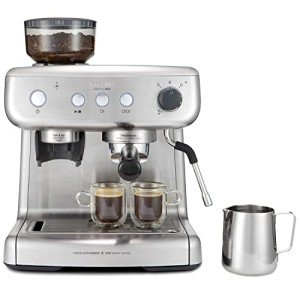The Art of Italian Espresso Machines: A Brewed Tradition
Italian espresso machines are not simply appliances; they are an essential part of Italy's rich coffee culture, representing a blend of artistry, engineering, and style. Coffee aficionados worldwide acknowledge the value of high-quality espresso, a staple of Italian life and food. This short article checks out the history, mechanics, types, and aspects to consider when purchasing an Italian espresso machine, showing the depth of this cherished beverage and its brewing techniques.
History of Espresso Machines
The espresso machine's evolution go back to the early 20th century in Italy, where coffee was not merely a beverage however an important social ritual. The initial attempts to brew espresso started with simple, stove-top designs, slowly developing into complex machines that could reproduce the best brew.
- 1901-- The First Espresso Machine: The very first steam-powered espresso machine, referred to as the "Ideale," was established by Luigi Bezzera. This machinery marked a turning point in espresso brewing.
- 1938-- The Lever Machine: The intro of the lever machine made it simpler to control the pressure used in espresso extraction, enhancing taste consistency.
- 1947-- The Automatic Machine: Reaching more consumers, Gaggia released the first automatic espresso machine, more popularizing espresso bars.
- 2007-- The Digital Age: Technological improvements resulted in the birth of completely programmable machines, allowing users to customize their brewing settings to achieve a tailored coffee experience.
Key Features of Italian Espresso Machines
Italian espresso machines embody precision, workmanship, and development. Here are some crucial parts that highlight their significance:
| Feature | Description |
|---|---|
| Boiler Type | Identifies how heat is generated and maintained. Typical types consist of single boiler, dual boiler, and heat exchanger. |
| Group Heads | Where the coffee is brewed; commercial machines often have numerous group heads for effectiveness. |
| Pressure Control | Important for attaining the ideal espresso; most machines operate at 9 bars of pressure. |
| Frothing Capabilities | The steam wand enables milk frothing, vital for beverages like cappuccino and latte. |
| Build Quality | The materials used (stainless-steel, brass, and so on) influence toughness and heat retention. |
Types of Italian Espresso Machines
Choosing the right machine hinges on user choices, budget, and planned use. Below are the main types of Italian espresso machines:
Manual Espresso Machines
- Pros: Offer full control over the developing procedure, allowing for a tailored touch.
- Cons: Require skill and practice, can be labor-intensive.
Semi-Automatic Machines
- Pros: Provide a balance in between automated and manual procedures; users control water flow.
- Cons: Can have a steeper knowing curve than completely automatic machines.
Fully Automatic Machines
- Pros: Simplify the brewing process with push-button operations; suitable for newbies.
- Cons: May sacrifice a few of the nuances of manual brewing.
Super-Automatic Machines
- Pros: Grind, tamp, brew, and froth immediately; convenient for hectic way of lives.
- Cons: Less control over the developing variables, potential for a less authentic espresso experience.
Buying Guide: Factors to Consider
Choosing the perfect Italian espresso machine can be difficult, however thinking about the following factors can simplify the decision-making process:
- Budget: Italian espresso machines vary from affordable to high-end models, so set a budget upfront.
- Usage Frequency: Evaluate how often you will use the machine; day-to-day users might want a more long lasting option.
- Area: Measure your cooking area or counter area; some machines can be large and need sufficient clearance.
- Maintenance: Consider ease of cleaning; machines with detachable parts or built-in cleansing functions might minimize maintenance.
- User Skill Level: Beginners may choose fully or semi-automatic machines, while knowledgeable baristas can manage manual machines.
- Brand Reputation: Research brands known for quality, such as Breville, Gaggia, and La Marzocco.
Popular Italian Espresso Machine Brands
Italian workmanship is renowned for producing a few of the best espresso machines worldwide. Here are top brands worth considering:
- Gaggia: Known for its home espresso machines and cost.
- La Marzocco: A superior brand understood for its commercial-grade machines and innovative innovation.
- Rancilio: Renowned for its durable construct and professional-quality machines ideal for home and commercial use.
- Sage/Breville: Offers advanced functions and user-friendly styles, ideal for both beginners and enthusiasts.
Frequently asked questions
What is the distinction between espresso and regular coffee?
Espresso is a concentrated coffee brewed by forcing hot water through finely-ground coffee under pressure. It has a thicker consistency, richer flavor, and greater caffeine concentration than regular coffee.
Can I make milk-based beverages with an espresso machine?
Yes, lots of Italian espresso machines include a steam wand to froth milk for drinks like coffees, lattes, and macchiatos.
How often should I clean my espresso machine?
Regular upkeep is necessary. Generally, Top Espresso Machines is advised every few weeks, while descaling ought to be done every 1 to 3 months, depending upon water firmness.
What is the ideal pressure for brewing espresso?
The perfect pressure for brewing espresso is around 9 bars. This pressure makes sure the ideal extraction of flavors from the coffee grounds.
Are more pricey machines worth the investment?
Higher-end machines frequently utilize much better materials and technology, providing enhanced resilience and more consistent results. For severe coffee fans, buying a good machine can elevate the espresso experience substantially.
Italian espresso machines are a lot more than simple brewing devices; they are an event of a cultural custom that has affected coffee intake worldwide. With various models readily available to fit any user's requirements-- ranging from novices to seasoned baristas-- there is an Italian espresso machine completely matched for everyone. As you start your espresso journey, comprehending the history, mechanics, and options will enhance your experience and appreciation for this time-honored drink. Whether you look for to recreate a coffee shop atmosphere in your home or fine-tune your brewing technique, these machines are capable of providing extraordinary cups of espresso adorned with the abundant history of Italian coffee culture.

